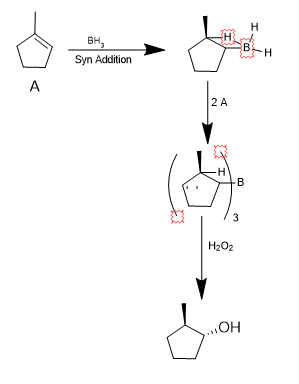Chemistry
10th Edition
ISBN:9781305957404
Author:Steven S. Zumdahl, Susan A. Zumdahl, Donald J. DeCoste
Publisher:Steven S. Zumdahl, Susan A. Zumdahl, Donald J. DeCoste
Chapter1: Chemical Foundations
Section: Chapter Questions
Problem 1RQ: Define and explain the differences between the following terms. a. law and theory b. theory and...
Related questions
Question
Can i get help with these problems

Transcribed Image Text:**Identify the reagents that you would use to accomplish each of the following transformations:**
(Note: The rest of the content including specific transformations or diagrams is not visible in the provided image snippet. Additional details would be required to provide a complete explanation of any diagrams or transformations.)

Transcribed Image Text:### Image Transcription for Educational Use
#### Reaction (f)
- **Reactant:** A cyclopentene molecule with a methyl group attached.
- **Reaction Arrow:** Indicates the transformation of the reactant into the products.
- **Products:**
- A cyclopentanol molecule with the hydroxyl group (OH) attached at the same carbon as the former double bond, and a methyl group.
- "En" indicating an additional product or byproduct that might be a part of the reaction but is unspecified here.
#### Reaction (h)
- **Reactant:** A cyclohexane ring with a double-bonded ethyl group (alkene).
- **Reaction Arrow:** Indicates the transformation of the reactant into the product.
- **Product:** A cyclohexane ring with a bromine (Br) atom attached, replacing the former double bond with an alkyl group.
The diagrams represent organic reactions, likely involving addition reactions or substitutions. The notation used suggests stereochemistry and structural changes that occur during these transformations.
Expert Solution
Step 1
Alkenes show Additions reaction. they show electrophilic addition reaction as characteristic reaction. Part F deals with hydration over unsaturated bond and part H deals with HBr addition over unsaturated bond.
Step 2
Part F
here we need to follow antimarkownikoff addition of water over the reactant. Now, antimarkownikoff addition of water can be achieved through hydroboration of alkenes followed by oxidation.

Step by step
Solved in 3 steps with 2 images

Knowledge Booster
Learn more about
Need a deep-dive on the concept behind this application? Look no further. Learn more about this topic, chemistry and related others by exploring similar questions and additional content below.Recommended textbooks for you

Chemistry
Chemistry
ISBN:
9781305957404
Author:
Steven S. Zumdahl, Susan A. Zumdahl, Donald J. DeCoste
Publisher:
Cengage Learning

Chemistry
Chemistry
ISBN:
9781259911156
Author:
Raymond Chang Dr., Jason Overby Professor
Publisher:
McGraw-Hill Education

Principles of Instrumental Analysis
Chemistry
ISBN:
9781305577213
Author:
Douglas A. Skoog, F. James Holler, Stanley R. Crouch
Publisher:
Cengage Learning

Chemistry
Chemistry
ISBN:
9781305957404
Author:
Steven S. Zumdahl, Susan A. Zumdahl, Donald J. DeCoste
Publisher:
Cengage Learning

Chemistry
Chemistry
ISBN:
9781259911156
Author:
Raymond Chang Dr., Jason Overby Professor
Publisher:
McGraw-Hill Education

Principles of Instrumental Analysis
Chemistry
ISBN:
9781305577213
Author:
Douglas A. Skoog, F. James Holler, Stanley R. Crouch
Publisher:
Cengage Learning

Organic Chemistry
Chemistry
ISBN:
9780078021558
Author:
Janice Gorzynski Smith Dr.
Publisher:
McGraw-Hill Education

Chemistry: Principles and Reactions
Chemistry
ISBN:
9781305079373
Author:
William L. Masterton, Cecile N. Hurley
Publisher:
Cengage Learning

Elementary Principles of Chemical Processes, Bind…
Chemistry
ISBN:
9781118431221
Author:
Richard M. Felder, Ronald W. Rousseau, Lisa G. Bullard
Publisher:
WILEY